
Contents
Traveler’s Diarrhea
Traveler’s diarrhea is defined as three or more unformed stools in 24 hours, passed by a person who is traveling. It is commonly accompanied by abdominal cramps, nausea, and bloating. Traveler’s diarrhea is a general term and does not specify any cause. Travelers from temperate regions frequently experience diarrhea four days to two weeks after arriving in certain areas.
Other terms used to describe this illness include:
- "Montezuma’s Revenge, "the "Aztec Two Step," and "Turista" in Mexico
- The "Delhi Belly" in India
- The "Hong Kong Dog" in the Far East
What causes traveler’s diarrhea?
Traveler’s diarrhea is usually contracted by the ingestion of contaminated food or water. Contrary to belief, food is the primary cause. Up to 80% of cases are caused by bacteria. The most common bacterium is enterotoxigenic E. coli, one of six classes of enterovirulent E. coli.
Most E. coli are harmless. However, six unique classes can cause inflammation of the stomach and bowels (gastroenteritis) and are termed enterovirulent. They are virulent to the intestine (or, in Greek, the enteron).
Collectively, these six classes of enterovirulent E. coli are referred to as the EEC group. Each class of EEC is distinct and different from the others.
- Enteroinvasive E. coli (EIEC) invades the intestinal wall to produce severe diarrhea.
- Enterohemorrhagic E. coli (EHEC) is a type of EHEC, E.coli0157:H7 that can cause bloody diarrhea and hemolytic uremic syndrome (anemia and kidney failure).
- Enterotoxigenic E. coli (ETEC) causes most travelers’ diarrhea and produces a toxin that acts on the intestinal lining.
- Enteropathogenic E. coli (EPEC) can cause diarrhea outbreaks in newborn nurseries.
- Enteroinvasive E. coli (EIEC) invade the epithelial cells causing diarrhea with mucus and blood.
- Enteroaggregative E. coli (EAggEC) can cause acute and chronic diarrhea in children.
Other bacterial species implicated in traveler’s diarrhea include Campylobacter jejuni, Shigella, and Salmonella. Viruses less commonly are causes of traveler’s diarrhea. Parasitic infections are an uncommon cause except for Giardia lamblia, which should be suspected in individuals traveling to Russia or mountainous regions of the Northern Hemisphere. Cryptosporidum, another parasite, also has been implicated as a common cause of diarrhea in visitors to St. Petersburg, Russia, and elsewhere.
Who is most at risk for traveler’s diarrhea?
Twenty percent to 50 percent of international travelers may develop diarrhea depending on the region they visit. Diarrhea is the most common illness of travelers, affecting 10 million people each year, according to the CDC.
In general, travelers at risk for diarrhea commonly come from industrialized nations and travel to high-risk areas primarily within developing or less industrialized nations, including:
- Latin America
- Africa
- The Middle East
- Asia
Areas of lesser risk include China and some Caribbean nations. Travel to areas of the United States, Canada, Northern Europe, and Australia poses the lowest risk to travelers.
Other risk factors for traveler’s diarrhea include:
- Men and women are at equal risk.
- Younger individuals are more commonly afflicted.
- People with immune system disorders, diabetes, and underlying abdominal disorders are more susceptible.
- People taking acid blockers for their stomachs also have a higher susceptibility to travelers’ diarrhea.
What are the symptoms of traveler’s diarrhea?
The symptoms of traveler’s diarrhea vary. Generally, diarrhea occurs within the first week of travel and lasts up to three to four days.
Signs and symptoms of traveler’s diarrhea include:
- Affected individuals on average pass up to five loose or watery bowel movements per day, which may be associated with cramps.
- On occasion, individuals may experience fever or bloody stools.
- Diarrhea may be accompanied by abdominal pain, bloating, increased stomach/intestinal noises, and gurgling.
How is traveler’s diarrhea diagnosed?
The presumptive diagnosis of traveler’s diarrhea is based on the development of diarrhea when visiting a part of the world where this condition is common among travelers.
Diarrhea usually is mild, self-limited, and resolves spontaneously. Symptoms usually can be controlled with over-the-counter medications. Only when the diarrhea is severe or complicated should attempts be made to identify the exact organism responsible for diarrhea.
Identification may be difficult or impossible in undeveloped countries. When laboratories are available, the stool can be examined for parasites and cultured for bacteria. Identification of the pathogen results in a definitive diagnosis.
How is traveler’s diarrhea treated?
Prophylactic antibiotics generally are not recommended. Antibiotic prophylaxis can be considered in individuals with underlying medical diseases in whom diarrhea is more likely to occur or who may be profoundly affected by diarrhea. This group includes people with previous stomach surgery, active inflammatory bowel disease, underlying immunodeficiency conditions, and other serious medical disorders. In these situations, drugs of the quinolone class are effective.
Bismuth subsalicylate (Pepto-Bismol) is also effective in preventing diarrhea in up to 65% of travelers. When treating afflicted individuals, drugs that alleviate symptoms, as well as antibiotics, play a role. With moderate symptoms, the addition of Pepto-Bismol alone may suffice. Alternatively, anti-diarrheal agents such as diphenoxylate and atropine (Lomotil) or loperamide (Imodium) can be given. With severe disease, characterized by frequent diarrhea or dehydration, or complicated by the passage of bloody stools, Lomotil or Imodium should not be used and you should consult your doctor.
Oral fluids are a mainstay of therapy. Tips for staying hydrated include:
- Small, frequent sips of clear liquids are the best way to stay hydrated.
- Avoid alcoholic, caffeinated, or sugary drinks if possible. Over-the-counter rehydration products made for children are good to use if available.
- Sports drinks such as Gatorade and PowerAde are fine for adults if they are diluted with water.
- Try to drink at least as much or more fluid than you think is coming out or lost with watery diarrhea.
- For mild to moderate dehydration, oral rehydration salts (ORS) may be recommended.
- If the affected individual cannot hold down fluids or is losing fluids faster than they can take them in, seek medical care immediately.
Children and the elderly are more susceptible to dehydration. If a person feels light-headed or woozy, feels a rapid pulse or their mouth and lips are dry, they should consult a physician. If a child is listless, not eating or drinking, and does not make wet diapers or urinate within a few hours, they also should be seen quickly by a doctor.
By clicking Submit, I agree to the MedicineNet’s Terms & Conditions & Privacy Policy and understand that I may opt out of MedicineNet’s subscriptions at any time.


